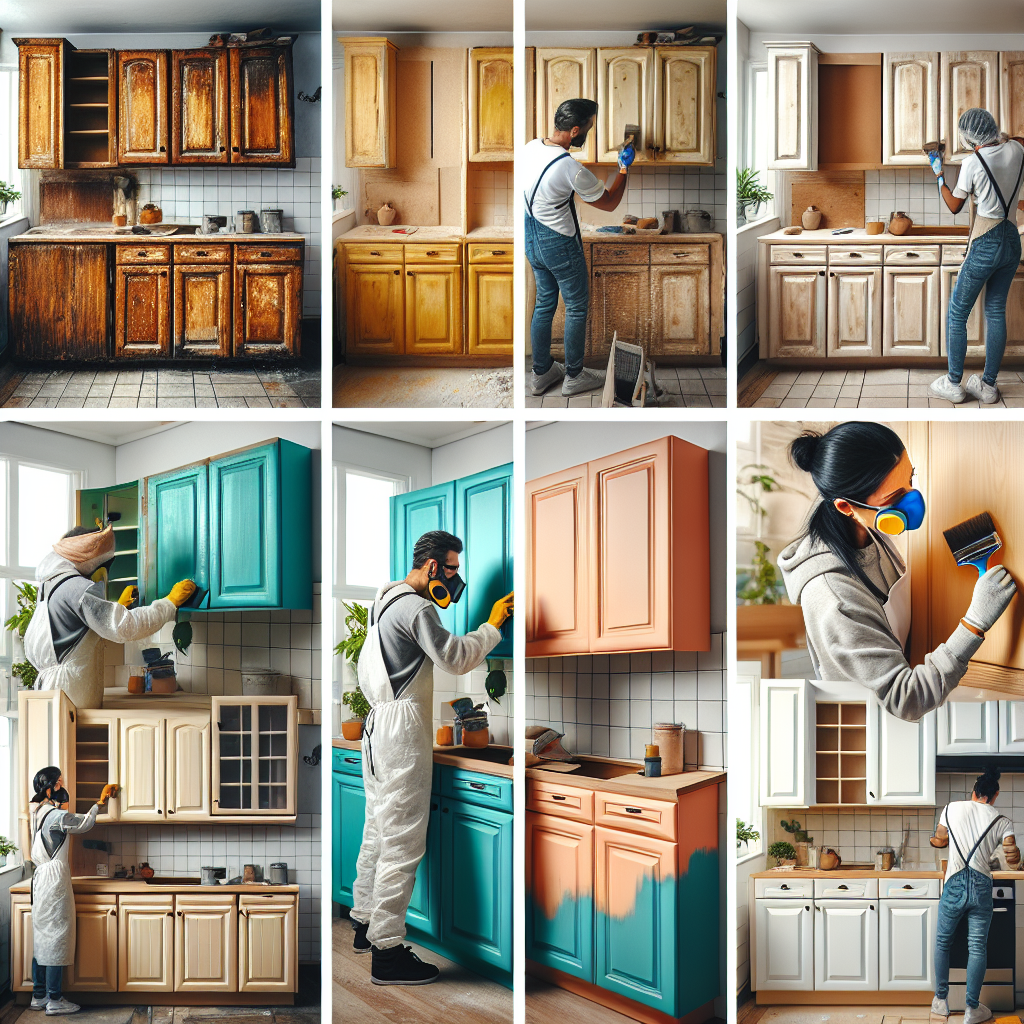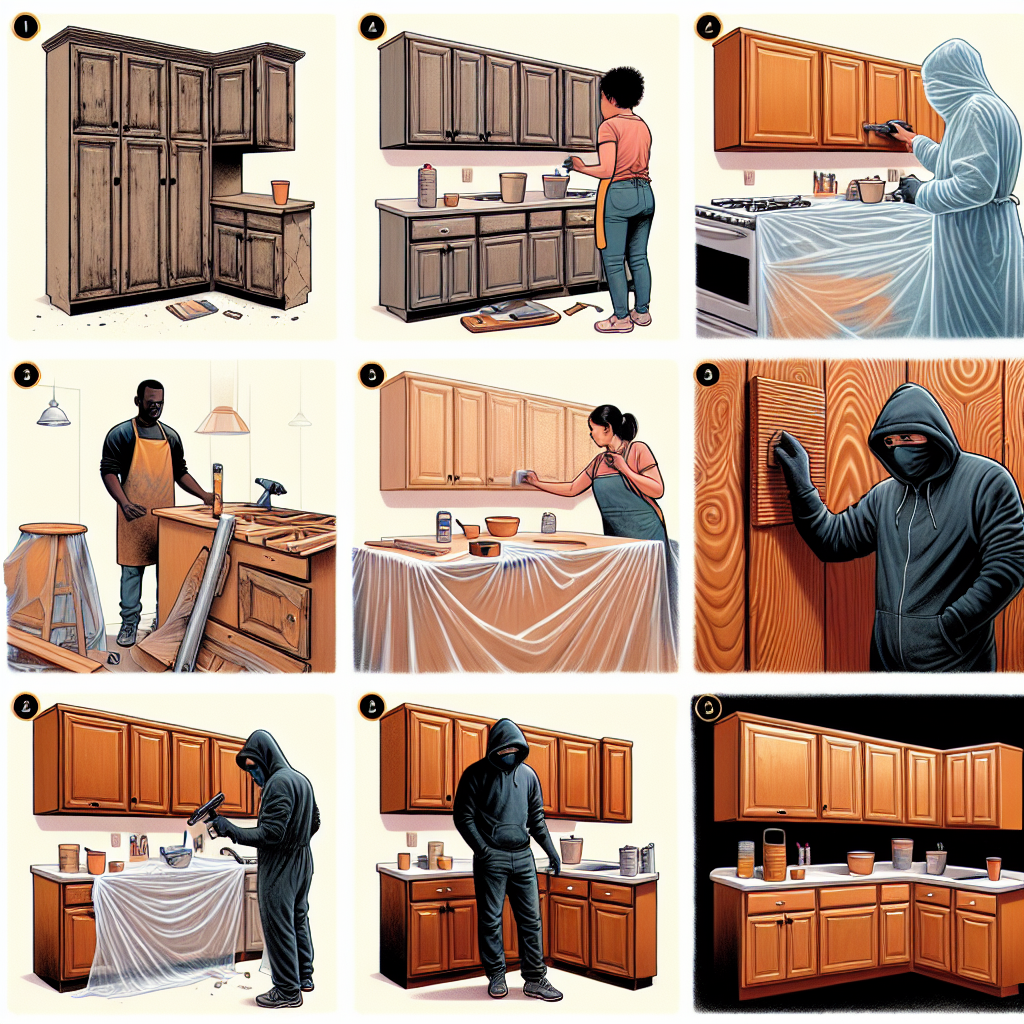Kitchen Cabinet Refinishing Guide

The Kitchen Cabinet Refinishing Process
Now that we have answered some common questions about kitchen cabinet refinishing, let’s dive into the step-by-step process to help you achieve professional-looking results:
1. Preparation
The key to a successful cabinet refinishing project is thorough preparation. Start by removing all items from your cabinets and labeling them to ensure easy reassembly later. Next, clean the cabinets thoroughly using a mild detergent and warm water to remove grease, dirt, and grime. Once clean, remove the cabinet doors, drawers, and hardware.
2. Sanding
Sanding is an essential step in the refinishing process as it helps remove the existing finish and creates a smooth surface for the new finish to adhere to. Use a medium-grit sandpaper or an electric sander to sand the cabinet surfaces, doors, and drawers. Be sure to sand in the direction of the wood grain to avoid scratches.
3. Repairing
Inspect your cabinets for any damages, such as cracks, dents, or holes. Fill these imperfections with wood filler and allow it to dry completely. Once dry, sand the repaired areas to ensure a seamless finish.
4. Priming
Priming is an important step to ensure proper adhesion of the new finish and to prevent stains or discoloration from bleeding through. Apply a coat of primer to all surfaces, including the cabinet frames, doors, and drawers. Use a high-quality brush or roller for an even application.
5. Painting or Staining
Now comes the fun part – applying the new color or stain to your cabinets. Choose a paint or stain that complements your kitchen design and apply it evenly using a brush or roller. Allow the first coat to dry completely before applying additional coats for a smooth and durable finish. If you prefer a natural wood look, opt for staining instead of painting.
6. Sealing
Once the paint or stain has dried, it is crucial to seal the cabinets to protect the finish and enhance durability. Apply a clear topcoat or polyurethane sealer to all surfaces, following the manufacturer’s instructions. This will provide a protective layer and make your cabinets easier to clean and maintain.
7. Reassembly
After the cabinets have fully dried, reattach the doors, drawers, and hardware. Take your time to ensure everything is aligned correctly and functioning smoothly. Clean up any remaining dust or debris, and your newly refinished cabinets are ready to shine in your kitchen.
When it comes Kitchen Cabinet Refinishing Guide and giving your kitchen a fresh new look, refinishing your cabinets can be a cost-effective and transformative solution. Instead of replacing your cabinets entirely, refinishing allows you to update their appearance while saving time and money. In this comprehensive guide, we will walk you through the process of kitchen cabinet refinishing, providing valuable insights and tips to help you achieve the best results.
Frequently Asked Questions about Kitchen Cabinet Refinishing Guide
1. What is kitchen cabinet refinishing?
Kitchen cabinet refinishing is the process of revitalizing your existing cabinets by removing the old finish, repairing any damages, and applying a new finish or paint. It involves several steps, including cleaning, sanding, priming, painting or staining, and sealing. Refinishing your cabinets can give them a fresh new look without the need for a complete replacement.
2. How much does kitchen cabinet refinishing cost?
The cost of kitchen cabinet refinishing can vary depending on various factors, such as the size of your kitchen, the condition of your cabinets, and the type of finish you choose. On average, homeowners can expect to spend between $1,500 and $4,000 for professional cabinet refinishing. DIY refinishing projects can cost significantly less, ranging from $200 to $600, depending on the materials and tools you use.
3. What are the benefits of kitchen cabinet refinishing?
Refinishing your kitchen cabinets offers several benefits:
- Cost savings: Refinishing is a more affordable option compared to replacing your cabinets entirely.
- Time efficiency: Refinishing takes less time than a full cabinet replacement, allowing you to enjoy your updated kitchen sooner.
- Customization: You have the freedom to choose the color, finish, and style that best suits your kitchen design.
- Eco-friendly: Refinishing your cabinets reduces waste by reusing existing materials instead of disposing of them.
4. Can I refinish my kitchen cabinets myself?
While it is possible to refinish your kitchen cabinets yourself, it requires careful preparation, patience, and the right tools. If you have experience with DIY projects and feel confident in your skills, you can save money by refinishing your cabinets on your own. However, if you are unsure or lack the necessary expertise, it is recommended to hire a professional cabinet refinishing service to ensure a high-quality result.
5. How long does kitchen cabinet refinishing take?
The duration of a kitchen cabinet refinishing project depends on various factors, including the size of your kitchen, the complexity of the refinishing process, and the drying time of the chosen finish. On average, a professional cabinet refinishing project can take anywhere from three to five days. DIY projects may take longer, especially if you are working on your own or have limited experience.
Conclusion
Kitchen cabinet refinishing is a cost-effective and transformative way to update the look of your kitchen. By following the step-by-step process outlined in this guide, you can achieve professional-looking results and enjoy a fresh new kitchen without the need for a complete cabinet replacement. Whether you choose to tackle the project yourself or hire a professional, refinishing your kitchen cabinets can breathe new life into your space and increase the value of your home.
For professional kitchen cabinet refinishing services in North Bay, visit Cabinet Refinishing North Bay.

